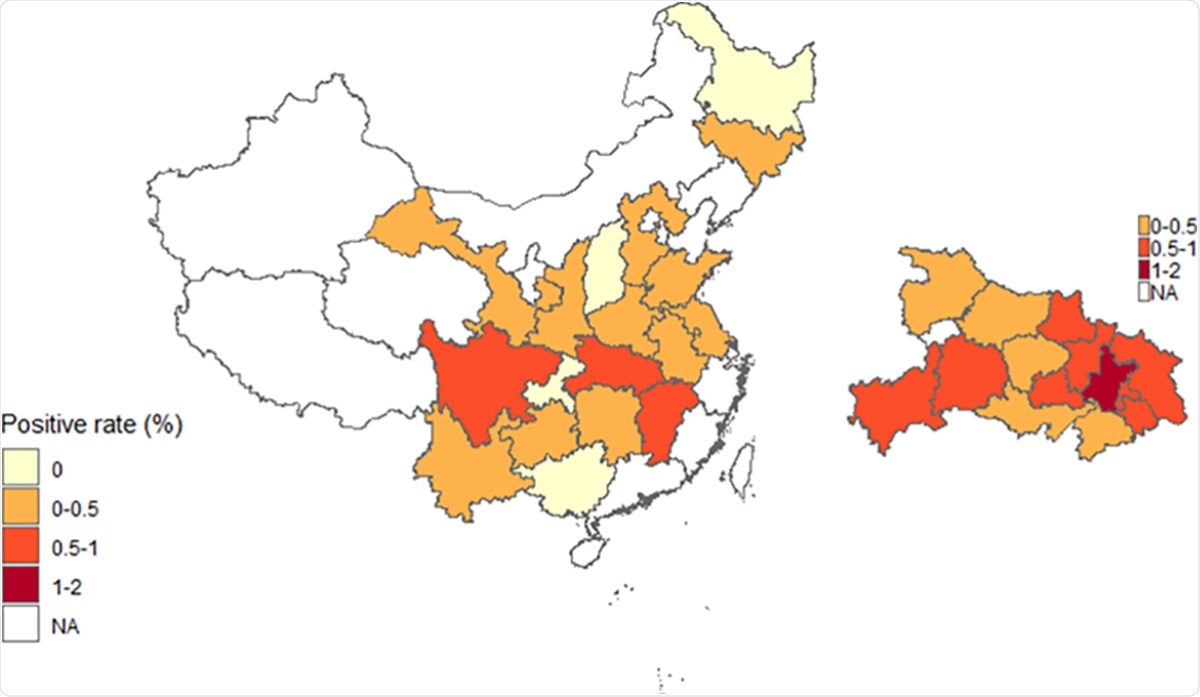The coronavirus disease 2019 (COVID-19), caused by the severe acute respiratory syndrome coronavirus 2 (SARS-CoV-2), was first reported in December 2019 in Wuhan City, China. Declared a global pandemic by the World Health Organization (WHO) in March 2020, COVID-19 continues to spread worldwide. To date, over 90.6 million confirmed cases and more than 1.93 million deaths have been reported worldwide.
As asymptomatic transmission chains play a role in SARS-CoV-2’s viral spread, a new study by researchers in Wuhan, China, investigated the seroprevalence and asymptomatic carrier status of SARS-CoV-2 in the region.
The research team made use of rapid and specific antibody (IgM and IgG) detection to determine whether a person had been infected with SARS-CoV-2. They recently published their work in PLoS Neglected Tropical Diseases.
The researchers analyzed the seroprevalence of SARS-CoV-2 in 63,107 healthy individuals in Wuhan and surrounding areas in mainland China from March 6 to May 3, 2020, who were returning to work after lockdown measures. They correlated this with geographic region, age, sex and the detection time.
This screening for IgM and IgG antibodies provides an estimate of the infection rate for SARS-CoV-2 in a population. The presence of IgM antibodies indicates that the person is currently or recently infected with SARS-CoV-2. While the IgG presence means the person was previously infected with SARS-CoV-2. Among the overall healthy individuals, the IgG antibody positive rate to SARS-CoV-2 was 0.68% (432/63,107) and the IgM was 0.18% (113/63,107).
SARS-CoV-2 seropositive individuals were identified in 18 of 30 provinces of mainland China. The researchers found that the seroprevalence to SARS-CoV-2 among China’s healthy population was 0.74% (465/63,107).
The researchers also found that the seroprevalence of SARS-CoV-2 was higher in Wuhan City (1.68%, 186/11,086) than in other parts of China (0.38%, 53/13,850).
This study shows that a large number of asymptomatic carriers of SARS-CoV-2 existed after the elimination of clinical cases of COVID-19 in Wuhan City. The researchers note that SARS-CoV-2 may exist in a population without clinical cases for a long period.
The results also showed that older individuals and females had higher seroprevalence – indicating a higher probability of being infected than males and younger individuals.
A significant influencing factor is ‘the geographic region’. The researchers note that this finding indicated that the probability of an individual having been infected with SARS-CoV-2 in Xiangyang City (0.13%) or Jingmeng City (0.23%) was 0.1 times or 0.17 times less than an individual in Wuhan City.

The total IgG and IgM antibody positive rate of SARS-CoV-2 in Hubei Province and other provinces with sample size >300 persons in mainland China.
The high seroprevalence of SARS-CoV-2 in cities in close geographic proximity to Wuhan City is suggestive of SARS-CoV-2 transmission from Wuhan City to its surrounding areas.
Consistent with a large number of COVID-19 cases having occurred in Wuhan, the seroprevalence of SARS-CoV-2 is significantly higher in Wuhan City than other regions of Hubei Province and other places in China.”
This study throws light on the epidemiologic utility of seroprevalence testing in gauging the presence of SARS-CoV-2 in a population.
The researchers also validate the relationship between the seropositive rate and influencing factors such as sex, age distribution and geographic region. They emphasize the significance of this study in guiding the resumption of work, production and school in China.
The absence of clinical symptoms indicates that asymptomatic carriers of SARS-CoV-2 exist in large areas in China, and many people were asymptomatic carriers of SARS-CoV-2 in Wuhan City. Therefore SARS-CoV-2 may exist in a population without clinical cases, the researchers conclude.
Journal reference:
Duan S, Zhou M, Zhang W, Shen J, Qi R, Qin X, et al. (2021) Seroprevalence and asymptomatic carrier status of SARS-CoV-2 in Wuhan City and other places of China. PLoS Negl Trop Dis 15 (1): e0008975. https://doi.org/10.1371/journal.pntd.0008975, https://journals.plos.org/plosntds/article?id=10.1371/journal.pntd.0008975